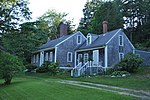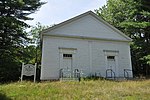Malaga Island
African-American history of MaineIslands of Casco BayIslands of MaineIslands of Sagadahoc County, MaineNational Register of Historic Places in Sagadahoc County, Maine ... and 3 more
Phippsburg, MainePopulated places established by African AmericansProtected areas of Sagadahoc County, Maine
Malaga Island is a 41-acre (170,000 m2) island at the mouth of the New Meadows River in Casco Bay, Maine, United States. It was the site of an interracial community from the American Civil War until 1911, when the residents were forcibly evicted from the island. It is now an uninhabited reserve owned and managed by the Maine Coast Heritage Trust. Public daytime access is permitted.
Excerpt from the Wikipedia article Malaga Island (License: CC BY-SA 3.0, Authors).Malaga Island
Malaga Island Trail,
Geographical coordinates (GPS) Address Nearby Places Show on map
Geographical coordinates (GPS)
| Latitude | Longitude |
|---|---|
| N 43.781666666667 ° | E -69.875 ° |
Address
Malaga Island Trail
Malaga Island Trail
04565
Maine, United States
Open on Google Maps






